Wawel tickets official site: bilety.wawel.krakow.pl
Base metals
The collection includes copper, brass, bronze, tin and iron artistic objects, made and decorated using
various techniques.
various techniques.
Apart from European objects exhibited in Wawel Royal Castle and Pieskowa Skała Castle chambers, the collection also includes a set of oriental Chinese, Persian and Armenian objects displayed in the ‘Oriental Art in the Wawel collection’ exhibition. The most valuable objects were obtained in the 1920s and 30s, through the efforts of the then curators, who aimed to recreate the functional character of castle interiors. They come from donations and purchases in Poland and abroad, e.g. from Karol Sheldon Phillips
from Paris, Szymon Szwarc from Vienna, the Fukier family from Warsaw, Jakub Judkiewicz from Kraków, Brunon Konczakowski from Cieszyn, and also from the Sieghardt collection from Austria.
Particularly noteworthy are four sarcophagi of Sieniawski family members: Adam Hieronim, Mikołaj, Aleksander and Prokop, with recumbent representations of the deceased on the lids. Made of tin and lead alloy, most probably in the years 1619-1636 in Lvov by Wrocław sculptor, Hanusz Pfister, intended for the Brzeżany castle chapel, they are unparalleled in Polish art. They are exhibited in Pieskowa Skała.
The following sets are unique in Poland: fireplace tool sets (Renaissance French and Italian, and Baroque Dutch), candlesticks (including Baroque embossed spotlights and Classicist gilt bronze candelabras), ornamented brass vessels (Nuremberg bowls) and copper vessels (wine coolers, pitchers and containers), chemist’s mortars (Gothic, Renaissance and early Baroque), and tin items.
Objects representing early Polish culture constitute separate groups, such as pen cases with inkwells, scissors for cutting candle wicks, complicated locks, padlocks, keys and even a 17th-c. treasury door; keepsakes of a patriotic character (boxes in the shape of royal sarcophagi, national heroes’ statuettes) and bronze study room sculptures with various themes.
Keepsakes of the royal Vasa family are of unique value; they include the inscription cartouche from Karol Ferdynand Vasa’s sarcophagus, and a cartouche with Sigismund III Vasa’s coat of arms, most probably from a carriage the king used.
from Paris, Szymon Szwarc from Vienna, the Fukier family from Warsaw, Jakub Judkiewicz from Kraków, Brunon Konczakowski from Cieszyn, and also from the Sieghardt collection from Austria.
Particularly noteworthy are four sarcophagi of Sieniawski family members: Adam Hieronim, Mikołaj, Aleksander and Prokop, with recumbent representations of the deceased on the lids. Made of tin and lead alloy, most probably in the years 1619-1636 in Lvov by Wrocław sculptor, Hanusz Pfister, intended for the Brzeżany castle chapel, they are unparalleled in Polish art. They are exhibited in Pieskowa Skała.
The following sets are unique in Poland: fireplace tool sets (Renaissance French and Italian, and Baroque Dutch), candlesticks (including Baroque embossed spotlights and Classicist gilt bronze candelabras), ornamented brass vessels (Nuremberg bowls) and copper vessels (wine coolers, pitchers and containers), chemist’s mortars (Gothic, Renaissance and early Baroque), and tin items.
Objects representing early Polish culture constitute separate groups, such as pen cases with inkwells, scissors for cutting candle wicks, complicated locks, padlocks, keys and even a 17th-c. treasury door; keepsakes of a patriotic character (boxes in the shape of royal sarcophagi, national heroes’ statuettes) and bronze study room sculptures with various themes.
Keepsakes of the royal Vasa family are of unique value; they include the inscription cartouche from Karol Ferdynand Vasa’s sarcophagus, and a cartouche with Sigismund III Vasa’s coat of arms, most probably from a carriage the king used.
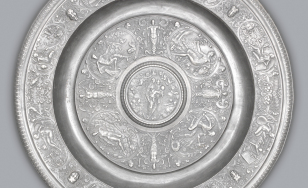 Copy of a platter with low relief. Germany, 1850; model Caspar Enderlein, Nuremberg, 1611
Copy of a platter with low relief. Germany, 1850; model Caspar Enderlein, Nuremberg, 1611
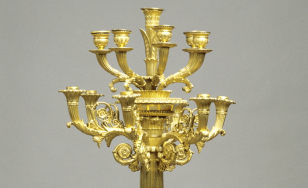 Candelabrum with twelve arms, France, Paris, Thomire Pierre Philippe, early 19th century
Candelabrum with twelve arms, France, Paris, Thomire Pierre Philippe, early 19th century
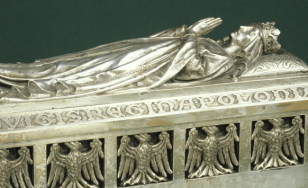 Model of the sarcophagus of Queen Jadwiga from Wawel Cathedral. Rome, Antoni Madeyski (1862–1939), 1900–1902
Model of the sarcophagus of Queen Jadwiga from Wawel Cathedral. Rome, Antoni Madeyski (1862–1939), 1900–1902
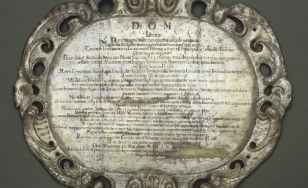 Cartouche with an inscription. From the sarcophagus of Prince Charles Ferdinand Vasa, Toruń, Jan Christian Bierpfaff (workshop), 1655
Cartouche with an inscription. From the sarcophagus of Prince Charles Ferdinand Vasa, Toruń, Jan Christian Bierpfaff (workshop), 1655
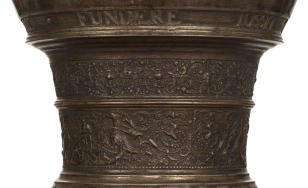 Apothecary’s mortar. Netherlands, Deventer, Gerrit Schimmel (active 1664–1705), 1683
Apothecary’s mortar. Netherlands, Deventer, Gerrit Schimmel (active 1664–1705), 1683
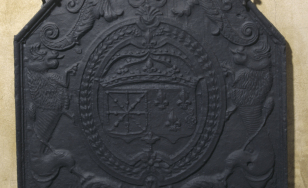 Fireback with the coats of arms of France and Navarre of Louis XIII. France, 1610–1630
Fireback with the coats of arms of France and Navarre of Louis XIII. France, 1610–1630
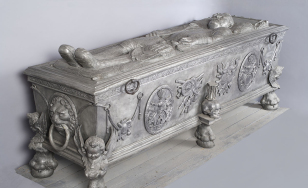 Sarcophagus of Adam Hieronim Sieniawski, Deputy Cup-Bearer of the Crown. Lwów, 1619–1625, casting workshop belonging to the Frank family, executed according to a model by Jan Pfister (1573–1642) (workshop)
Sarcophagus of Adam Hieronim Sieniawski, Deputy Cup-Bearer of the Crown. Lwów, 1619–1625, casting workshop belonging to the Frank family, executed according to a model by Jan Pfister (1573–1642) (workshop)
LOG IN
REGISTRATION
